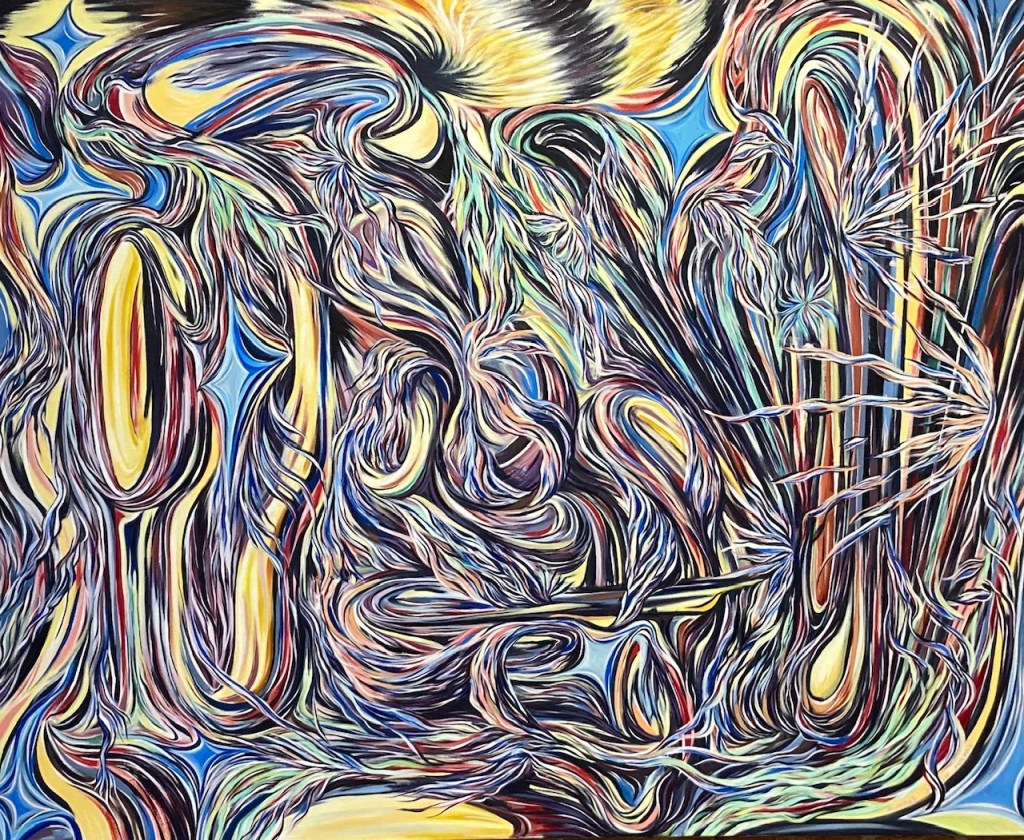It is easy to appreciate the paintings of Markus Puskar, with their swirling colors and shapes, their out-of-this world spirituality, their blatant and primitive references to sacred practices and the human body.

The oil-on-canvas works, currently on display at Denver’s Leon Gallery, vibrate like psychedelic posters from the 1960s set under a black light. The lines — in banana yellows, tangerine oranges, cranberry reds — twist and turn and suggest an irrational understanding of how the universe works. Sometimes they are loosely-configured landscapes depicting the terrain of the West. Other times, they play out like mental journeys traveling to some weird and surreal place.
Puskar is new on the visual arts scene here, and very much a talent in development. The literature Leon provides to accompany the show describes him a self-taught artist and full-time social worker who paints as an additional, and certainly evolving, interest.
He is open about his lack of formal training, and that is refreshing. Artists like to posture; it is part of a game that keeps their efforts mysterious and makes the commodities they produce precious. But there are many ways to succeed in the art world, and being frank about how an artist thinks and produces and refines ideas is among the most endearing.
Puskar lays out his process in the artist’s statement he provides for this outing, explaining how he came to create these paintings that explore ideas of nature and divinity, drawing inspiration “from folk art and spiritual art, particularly that of northern New Mexico.”
He was, he writes, searching for a way to paint the divine, and he found it by rejecting logic and indulging in “a sense of wonderment and gratitude that I had concealed from even myself.” He stopped worrying about what people would think of the work and just painted.
He writes: “I found myself casting off the cold rationality that told me sincerely expressing awe was uncouth.”
You can see that path in the works at Leon. The piece titled “I Wish I Could Remember,” for example, starts off as an ordinary, impressionistic landscape with hills, valleys and a winding river flowing through it all. It reminds me of something that might have come out of a Santa Fe art school in the mid-20th century.

But up in the sky are three suns, hovering over the horizon. It is impossible to know if Puskar is portraying the sun at three different times as it rises over the Earth on its daily path, or if this trio of suns exist simultaneously. Either way, there is a deep respect for the natural order — and, simultaneously, an acceptance that the world works in unknown ways. It’s a simple painting, bordering on naive, but it is surely open-minded.
There are other landscapes with a similar feel. Both “A Concerning Alliance,” which captures a coyote prowling through a desert, and “Salt Creek,” which appears to depict rock formations at the edge of a lake, have a super surrealistic aura. They mix the facts of nature with ideas about how everything is connected. Clouds can look like worms crawling across the sky. Craggy cliffs take on the appearance of human veins and muscles that pulse through the body. It’s a little grotesque at times, but the truth is that everything is actually connected in the universe, and Puskar’s scenes remind us of this truth.
The exhibit reaches its visceral heights when Puskar moves all the way forward with his idea of self-liberation. There are big and lush paintings that let go entirely of the notion that viewers have to understand immediately what they are seeing.
“Float,” for example, is just a goo of curling lines that seem to capture light waves, in brilliant colors, floating through the atmosphere in no particular direction. Though, to be honest, it might just be more rocks and lakes. The fact that it is hard to tell is what makes the piece interesting.
More abstract, and more spiritual, are paintings like “The Age of Re-Enchantment” and “Narcissus at the Pond.” Both incorporate disconnected elements — flowers, planets, disembodied legs, eyeballs and hands — into viscous collages that seem to capture dreams, or perhaps hallucinogenic drug trips, that a viewer could spend a lifetime trying to understand.
These are not new ideas, of course. They reference age-old ideas of religion and attempts to comprehend deeper the connections within our physical and psychic selves. Puskar understands that, and gives a special nod to the influence on his work of the Santuario de Chimayo, the historic chapel in Chimayo, N.M.

He is not pretending to re-invent the uber-universe, just to present his own awareness and fascination with it. And, it’s important to say, his ego is not getting in the way of offering a good bargain. The prices on these works reflect the concept that he is heading on a path, rather than arriving at a destination. It’s excellent that Leon Gallery, a non-profit, recognizes the need to support artists at all levels of their careers.
The enjoyment in the exhibit — also titled “The Age of Re-Enchantment” — is following the narrative that Puskar establishes in his artist statement, because it is larger than the personal story of one artist. It serves as a primer on how all painters, photographers, sculptors and other object-makers move toward things that are pure and not self-conscious.

